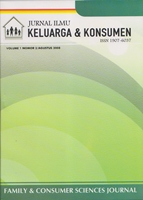STRATEGI PENYEIMBANGAN ANTARA AKTIVITAS PEKERJAAN DAN KELUARGA PADA WANITA BEKERJA DI BOGOR
Abstract
The main purpose of this research was to know the working women’s strategies in balancing between work and domestic activities. Specifically, the objectives were to determine: (1) the contribution of working women in the result of the wealthy of the family, (2) working women’s strategy in balancing between work and domestic activities, (3) social support in helping working women in balancing between work and domestic activities, and correlation between variables. The respondents were working women who work in full-time and have a family, consist of husband and a child or children. This was a cross sectional study which was performed among 50 working women in Bogor in March 2005. The results showed that most of respondents balanced between work and family activities. Another strategy that was used by almost all respondents was paying maid to help them in finishing domestic activities. The community and extended families surrounded respondents supported them very well through providing social supports. Working women’s strategy had significant correlated with the numbers of children in school-aged, the length of domestic time, and the length of personal time. The overall wellbeing of the family was measured by respondents’ satisfaction towards their resource. It was found that the family well-being had significant correlation with the total of husband’s income, contribution of respondents’ income, extended family social support, and the working women’s strategies.
Authors submitting manuscripts should understand and agree that copyright of manuscripts published are held Jurnal Ilmu Keluarga dan Konsumen. The statement to release the copyright to Jurnal Ilmu Keluarga dan Konsumen is stated in Copyright Release Form. Copyright encompass exclusive rights to reproduce, to distribute, and to sell any part of the journal articles in all form and media. The reproduction of any part of this journal is allowed with a written permission from Jurnal Ilmu Keluarga dan Konsumen.









